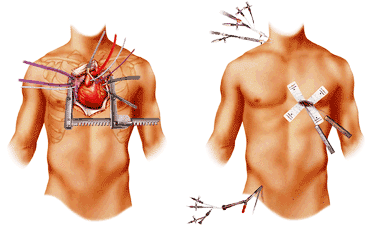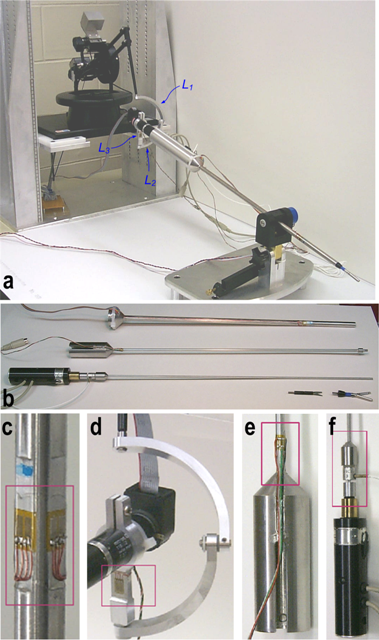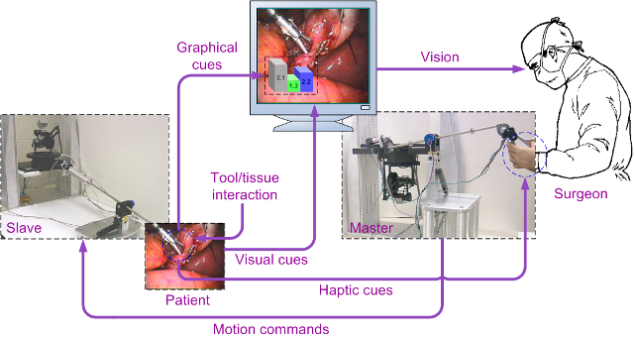Teleoperation Systems For Robot-assisted Minimally Invasive Surgery
Teleoperation Systems For Robot-assisted Minimally Invasive Surgery
Researchers: Mahdi Tavakoli, Rajni V. Patel, Mehrdad Moallem
Minimally invasive surgery
Our research interests are in incorporating haptic interaction and image guidance in computer-assisted surgery and therapy, which mainly involve the areas of medical robotics (including haptics, teleoperation and controls) and medical image processing. Our application of interest has so far been minimally invasive surgery (MIS). In minimally invasive (endoscopic/laparoscopic) surgery, thin instruments are inserted into the body cavity through small incisions rather than making a large incision as in open surgery.

Open surgery (left), minimally invasive surgery (right). [Picture from Anova Heart and Vascular Institute website]
Conventional versus robot-assisted MIS
Although MIS significantly reduces patient morbidity and length of hospital stay because of the small incision size, it has inherent drawbacks to the surgeon in terms of motor functioning and sensory capabilities. These include significantly degraded haptic feedback about instrument/tissue interactions, degraded visual feedback, and reduced dexterity and fine manipulation capability. Image-guided MIS attempts to use medical images (ultrasound, CT, etc.) to automate tasks through guiding surgical instruments to desired positions in the patient, generally either through incorporation with the control algorithm for a surgical robot or through virtual reality (e.g., image overlays on the endoscopic camera view in MIS) used to inform the surgeon. I am interested in the use of robotic and mechatronic systems, haptic interaction and image guidance for tackling the motor/sensory limitations that exist in MIS (or similar medical and biomedical applications).
A teleoperation system with haptic interaction
With a limited maneuverability of surgical instruments and restricted camera vision experienced in MIS, haptic feedback to the surgeon can be very helpful and make these kind of procedures more natural and less cumbersome. Studies have shown that the presence of haptic interaction in master-slave teleoperation, whereby a user operates from and receives force feedback via a master interface while a slave robot mimics the user’s hand maneuvers, enables significantly better control over tool-tissue interaction. The lack of haptic interaction has been identified as a major drawback of the current robotic-assisted surgical system, and a satisfactory solution has yet to be developed.
Our research has pertained to devices and methods required for restoring haptic feedback in robot-assisted MIS. In terms of devices, I augmented a 3-DOF PHANToM haptic device with two additional degrees of freedom to form a surgeon-robot interface with full force reflection capabilities. I also designed a slave surgical end-effector with force sensing capabilities in all of the five degrees of freedom present in laparoscopic surgery.


Top: (a) Haptic user interface for endoscopic interventions. Mechanisms for force reflection in the finger loops (b) and the roll mechanism (c).
Bottom: (a) Sensorized slave robot including the end-effector, the wrist, the twist motor, and the tip actuation assembly. (b) Details of the tip actuation assembly: the three tubes and two different detachable tips. (c) Gauges to measure bending moments. (d) Gauges to measure axial forces. (e) A gauge to measure torsional moment. (f) A load cell to find tip forces.
The resulting teleoperation system is shown below.

Related publications:
- M. Tavakoli, R.V. Patel, M. Moallem, A Haptic Interface for Computer-Integrated Endoscopic Surgery and Training, Virtual Reality (special issue on Haptic Interfaces and Applications), vol. 9, no. 2-3, pp. 160-176, March 2006. (SpringerLink) (BibTex) (pdf)
- M. Tavakoli, A. Aziminejad, R.V. Patel, M. Moallem, Methods and Mechanisms for Contact Feedbackin a Robot-Assisted Minimally Invasive Environment, Surgical Endoscopy and Other Interventional Techniques, vol. 10, no. 20, pp. 1570-1579, October 2006. (SpringerLink) (PubMed) (pdf)
- M. Tavakoli, R.V. Patel, M. Moallem, Haptic Interaction in Robot-Assisted Endoscopic Surgery: A Sensorized End Effector, The International Journal of Medical Robotics and Computer Assisted Surgery, vol. 1, no. 2, pp. 53-63, January 2005. (Wiley InterScience) (BibTex) (pdf)
%# M. Tavakoli, R.V.Patel, M. Moallem, Design Issues in a Haptics-Based Master-Slave System for Minimally Invasive Surgery, 2004 IEEE International Conference on Robotics and Automation, pp. 371-376, New Orleans, LA, April 2004. (IEEE Xplore) (BibTex) (pdf)
%# M. Tavakoli, R.V. Patel, M. Moallem, A Force Reflective Master-Slave System for Minimally Invasive Surgery, 2003 IEEE/RSJ InternationalConference on Intelligent Robots and Systems, pp. 3077-3082, Las Vegas, NV, October 2003. (IEEE Xplore) (BibTex) (pdf)